Schuster Institute for Investigative Journalism
at Brandeis University
i n v e s t i g a t i o n s































































Our investigation reveals that some palm oil--the most widely used vegetable oil in the world--is produced with slave labor. Palm oil is in all the products above, and many more.
Outline of Production:
Palm Fruit to Product
Outline of Production:
From Palm Fruit to Product
Palm Oil Supply Chain
The majority of palm oil produced in Indonesia and Malaysia is exported across the world—to India, China, the European Union, Egypt, the United States and other countries.
Some palm oil in these countries is produced within a processing system owned by a single company, such as New Britain Palm Oil Limited operating in the South Pacific. These supply chains are more easily managed for quality and consistency. Other palm oil is produced in supply chains that are more complex—involving multiple changes of corporate ownership as the palm oil passes from growers to mills, refiners, traders, chemical processors, manufacturers, and finally, to brand-name products sitting on our store shelves.
Tracing Palm Oil Through Supply Chains
Definitively confirming that a given product contains palm oil from a specific, single plantation is impossible unless the palm oil is certified at every step along the supply chain. This type of certification is called "Identity Preserved" (described in more detail below). Palm oil certified under systems other than Identity Preserved cannot be traced because stocks of various palm oil from various growers are mixed together along the processing pathway.
The vast majority (90%) of palm oil is non-certified and not traceable along the entire supply chain. In non-certified palm oil production, the oil crushed from one palm fruit passes through many production steps and is mixed with palm oil from multiple other plantations without any required documentation from a certifying body, which makes tracing a batch of non-certified palm oil back to one plantation estate impossible. (See "The Palm Oil Industry in Malaysia: From Seed to Frying Pan" by World Wildlife Fund for a thorough explanation of how palm oil is processed into the various ingredients we find in food and nonfood items.)
Is Forced Labor or Child Labor Hidden
in Our Favorite Brands?
It is still possible to link palm oil producers to food and chemical manufactures in the United States, however. After identifying plantations in Indonesia where labor abuses occurred, the Schuster Institute used the Import Genius shipping records database to trace palm oil harvested by workers at those plantations to refineries in Malaysia and then to some of the most prominent corporations in the United States.
For example, the Schuster Institute found that Kuala Lumpur Kepong Berhad (KLK), the company buying and refining the palm oil harvested on PT 198 plantation in Berau where workers told Schuster Institute investigative reporter E. Benjamin Skinner they were held against their will and sometimes forced into debt bondage, has sold palm oil or its derivatives to major manufacturing companies such as the agribusiness company Cargill, the chemical manufacturing giant BASF, and the multi-national personal care corporation Procter & Gamble. These companies then either further refine and sell that palm oil to end-use manufacturers or directly use the palm oil as an ingredient in a recognizable product on supermarket shelves.
-
Read "Indonesia's Palm Oil Industry Rife With Human-Rights Abuses," E. Benjamin Skinner, July 18, 2013, Bloomberg Businessweek.
Procter & Gamble’s Crest toothpaste, Oil of Olay Beauty Fluid, and Gillette Foamy Shaving Cream all include ingredients—sodium lauryl sulfate, glycerin, stearic acid, and cetyl palmitate—that can be derived from palm oil. Because Procter & Gamble (P&G) buys palm oil derivatives from KLK, it is theoretically possible that the palm fruit in these and other Proctor & Gamble products was sprayed with herbicides and harvested by forced labor or child labor on the PT 198 plantation. P&G, a member of the Roundtable on Sustainable Palm Oil, has committed to using 100% sustainable palm oil by 2015 according to its time-bound plans submitted to the RSPO in 2012. P&G says four percent of its total consumption is now from sustainable sources. As a grower, KLK has also committed to 100% CSPO by 2015 and reports 41% of its current production is RSPO-certified.
The graphic below illustrates key players in the palm oil supply chain featured in Bloomberg Businessweek's "Indonesia's Palm Oil Industry Rife With Human-Rights Abuses." It begins with the recruiting agent who, under false pretenses, contracted and transported workers to a palm oil plantation, to the multinational companies who purchased the palm oil or derivatives, and then from the palm oil processing companies that then used the palm oil or derivatives in popular brand name products sold around the world.
From Palm Oil Plantations to End-Use Products
How does a single palm fruit turn into an ingredient in your toothpaste? The palm oil supply chain can involve many steps: from plantation to mill, then to refinery for further chemical processing and manufacturing, and finally to the products we use every day.
The oil palm fruit, above, grows in large bunches that hang from the Elaeis guineensis tree which originated in West Africa. Today it is used in a plethora of grocery and household products, as well as in biodiesel. Nutella, a product on the store shelf behind the palm fruit, lists palm oil as its second ingredient after sugar. Ferrero, the company that makes Nutella, announced in April that it had switched to 100% CSPO (segregated) palm oil for its French market. Photo of store shelf by Roswitha Siedelberg.
Palm fruits grow in bunches and are cut off the tree with long-handled sickles.
Photo | Bremen Yong, RSPO
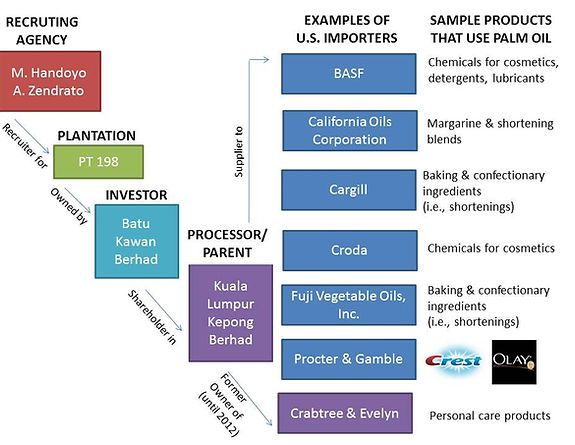
Graphic | Sophie Elsner

Photo | Michael Eilenberg
Oil palm saplings are tended in a nursery until they are mature enough to be planted in the plantation. In this photo by anthropologist Michael Eilenberg, indigenous Iban day laborers plant seedlings in West Kalimantan, March 2011. Eilenberg says the "cash-poor Iban embrace the immediate benefits of local employment. However, fears of exclusion from the long-term benefits of agriculture schemes and increased localized resource conflicts are immense." The inset video shows children helping in the nursery.
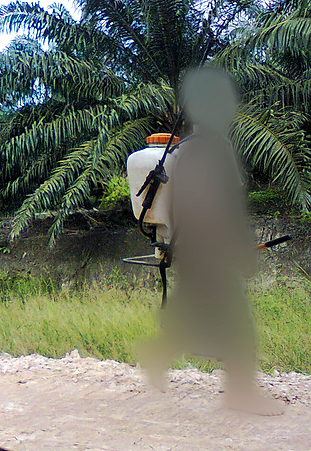
Photo | Agus Andrianto/CIFOR
Photo | Jonathan
Because of acidic soils and tropical climate, agrochemicals (fertilizers and herbicides) are considered a requisite for good palm oil production. Above left, workers on a palm oil plantation in Papua, Indonesia, apply fertilizer. Above right, a young worker heads into the plantation in Sumatra to spray herbicides on the trees and fruit. He wears no protective gear. The herbicide he is spraying is Paraquat, a neurotoxic herbicide known to cause liver and kidney damage that is banned in 32 countries. This child told the Schuster Institute's team of reporters he was expected to spray two hectares of land every day and said he does not go school. Paraquat and Glyphosate (Roundup) are the two most common herbicides used in the management of palm oil plantations.
Indonesia's labor laws are still based on Dutch Colonial Government Ordinance of 1925, which sets the actual legal working age at 12. Act No. 1 of 1951 raised that age to 14, but it was never implemented, according to the U.S. Department of Labor Bureau of International Labor Affairs. The Indonesian government has announced plans, through its Manpower Act, to raise the minimum working age to 15 for regular types of work and 18 for hazardous work such as applying herbicides and to altogether eliminate child labor for those between the ages of 7 and 15.
Learn more about human rights and public health concerns connected to palm oil production and development.

Photo | Menapak
Video | Etani
Above left, a young worker uses a long-handled sickle to cut bunches of palm fruit off the tree. Children are often seen collecting the loose palm fruitlets from the ground. The video above right is a commercial demonstration comparing the use of the manual tool versus a motorized machine.
Video | Pulitzer Center on Crisis Reporting
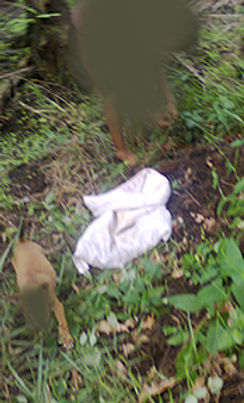
Photo | Jonathan


Photo | E. Benjamin Skinner
Photo | E. Benjamin Skinner
Skinner observed through his weeks of reporting in Indonesia that it is common to see people like this man on the side of a road in West Kalimantan (above left) raking palm fruit into piles. Once harvested, palm fruit must be taken to the mill within 48 hours before it rots. At the mill, the fresh fruit is sterilized, steamed and pressurized, purified, and then extracted for crude palm oil (CPO). Currently, Indonesia is on track to produce 31 million metric tons (MT) of palm oil in 2013, with Malaysia expected to produce 19 million MT, according to the U.S. Department of Agriculture. India and China are the world's largest importers of palm oil, followed by the European Union. The United States bought more than $1 billion of palm oil in 2011. See chart at bottom of this page for imports by other countries.
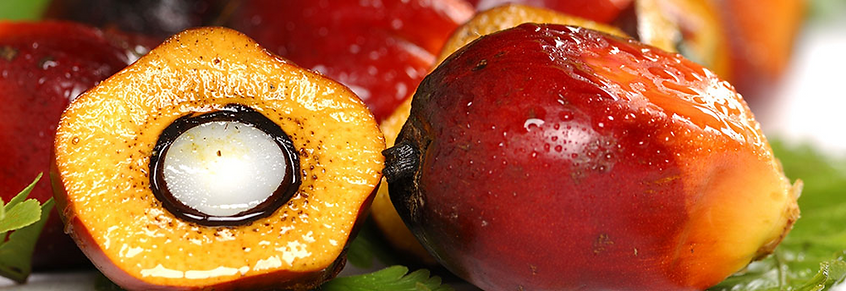
Photo | Bremen Yong, Roundtable on Sustainable Palm Oil
Above, palm fruit is a source of palm oil and palm kernel oil, each with unique properties. Palm oil, palm kernel oil, and their derivatives are used in a variety of products, including cosmetics, cleaning, personal care, biofuels, and processed food products. Some commonly seen derivatives are sodium lauryl sulfate, stearic acid, glycerin, and oleic acid.
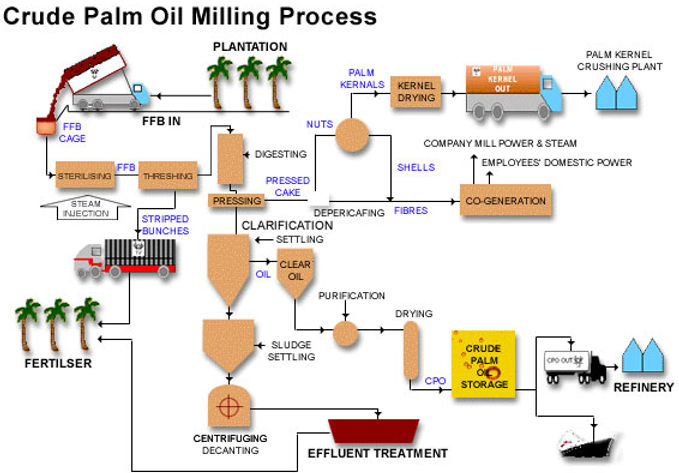
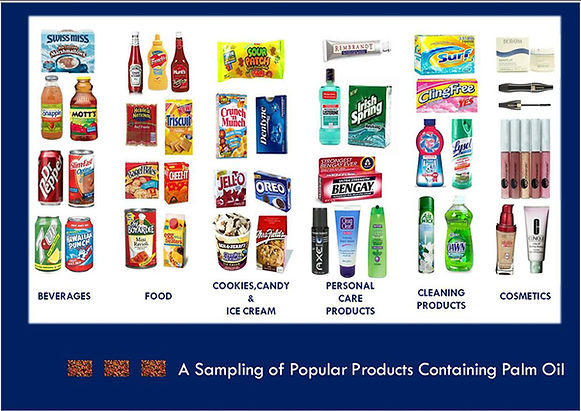
Graphic | Sabrina Patel
Companies purchase palm oil and its derivatives to use in the manufacture of thousands of popular food items and common household products such as the ones shown above. Learn more about products with palm oil.
Major Importing Countries of Palm Oil
Who uses the 55 million-plus metric tons of palm oil produced each year?
In 2012, India was the top importer of palm oil with 8.5 million metric tons, followed by China with 6.5 million metric tons, according to the USDA.
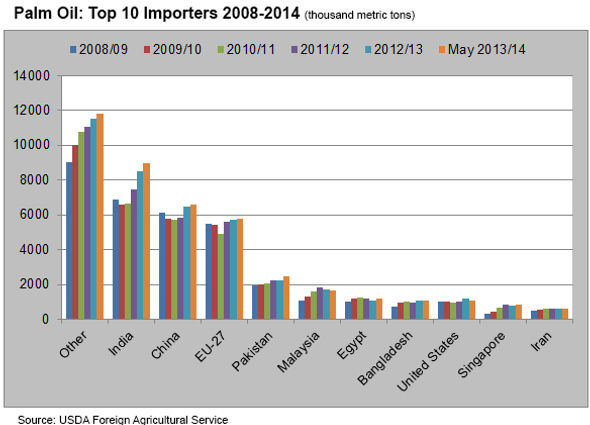
On this page
Tracing palm oil through supply chains
Is forced labor or child labor hidden in our favorite brands?
From palm oil plantations to end-use products
Major importing countries of palm oil
Links to other sections
1. Forced Labor on
Palm Oil Plantations
2. From Palm Fruit
to Product
1 | What is palm oil?
2 | Indonesia's palm oil industry
4 | Palm oil supply chain <
3. Human Rights Abuses & Other Controversies
4. Palm Oil Industry Response
4
Above left is an audio slideshow about migrant children working in palm oil plantations in Malaysian Borneo produced by the Pulitzer Center for Crisis Reporting. The child above right is collecting palm fruitlets on a palm oil plantation in Sumatra. While exact figures are unknown, according to the U.S. Department of Labor's 2012 report "List of Goods Produced by Child Labor or Forced Labor," child labor is prevalent on oil palm plantations in Indonesia. The Indonesian government has said that by 2020, it will have removed children between the ages of 7 to 15 from the labor force and given them opportunities to go to school. The minimum working age will be set at 15. The minimum age for hazardous work will be 18.
Above is a diagram of the milling process from fresh fruit bunches (FFB) to crude palm oil (CPO). "The Palm Oil Industry in Malaysia: From Seed to Frying Pan" by Teoh Cheng Hai (2002) for the World Wildlife Fund provides a good explanation of key processes and end uses.
Above, crude palm oil is pumped through pipes from tankards onto barges and vessels, as seen here at Johor Port in Pasir Gudang, Johor, Malaysia.
Photo | Goh Seng Chong, Bloomberg
21% of world palm oil imports went to India and 16% to China (2012/13)
USDA Foreign Agricultural Service.
Legislation to Combat Slavery in Supply Chains, California
Companies headquartered or doing business in California that meet certain requirements
must comply with the CA Transparency in Supply Chains Act 2010 (SB657).
Manufacturers that form part of this story about the palm oil industry and forced labor are listed below, with links to their online statements about what the company is doing
to ensure their supply chains
are free of slavery.
BASF
statement
California Oils Corporation
no statement
Cargill
statement
Colgate-Palmolive
statement
Kellogg
statement
Nestlé
statement
Proctor & Gamble
Statements listed above are
as of July 2013.
Since this project was published, some companies have pledged to improve industry practices.
Read more here.




